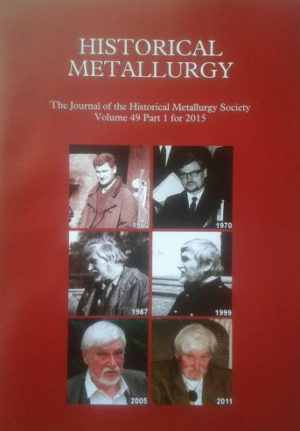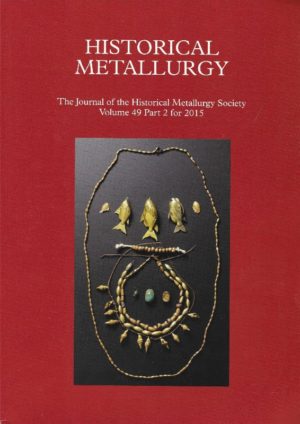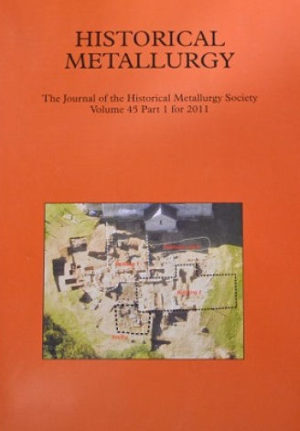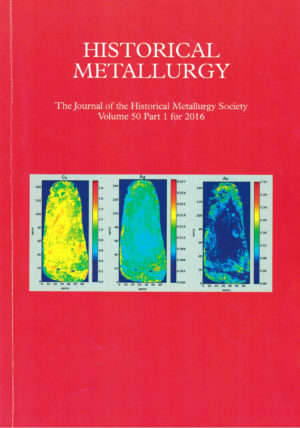Journal Contents
Gizeh iron revisited
P T Craddock and J Lang
Pages 57-59
Further examination of the iron plate from the Great Pyramid at Gizeh failed to detect any gold as previously reported. The authors of this paper confirm the metallographic structure but suggest this can be better explained in terms of known post-medieval iron fining technology rather than invoking unknown techniques from the remote past.
Examination of four Iron Age ferrous hammer heads from Bredon Hill (Hereford and Worcester), England
Vanessa Fell
Pages 60-70
Four hammerheads, provisionally dated to between the late 4th century BC and the early 1st century AD, were examined by metallography and electron microprobe to determine principally the methods of manufacture and any technological enhancements. Samples, taken near the faces, were found to comprise low/medium carbon steels. Two hammerheads had been quenched and possibly tempered, another was probably quenched and subsequently severely reheated, and the fourth was aircooled. Carburization in each hammerhead is interpreted as having derived from the bloom (primary carburization). The differences in the heat treatments applied were probably function related. The metallographic results are discussed in the context of other later Iron Age artifacts.
Early Mining and Metalworking: its impact on the Environment
T M Mighall and F M Chambers
Page 71-83
Historic mining and metalworking has altered the landscape in numerous ways, including changes in woodland composition, promoting river valley alluviation and sedimentation, and possibly causing pollution on a local scale. However, until recently, relatively little was known about the environmental impact of early mining and metalworking. This paper provides a review of new research, based on archaeological and palaeoenvironmental analyses (principally of pollen), which examines the effect of early metallurgical industries on the landscape, in particular on woodlands. Results from pollen analysis of peat deposits adjacent to two Bronze Age copper mines and one Iron Age ironworking site suggest that early mining and metalworkrng activities did not have a severe impact on woodlands. Woodland clearances were generally small-scale during the inferred period of industrial operations.
The statistical surveys of the British iron industry in 1797-98 and 1806
Chris Evans
Pages 84-101
The ironmasters of the eighteenth century were apt to portray theirs as the ‘the second trade in ye Kingdom’, acknowledging only the woollen industry as a more vital component of national prosperity. Such was their collective amour propre that they were notably alert to any threat to the well-being of their trade. Campaigns were undertaken to draw attention to the perils of an over-reliance on imported bar iron from the Baltic and elsewhere, to debate the wisdom of encouraging pig iron production in the American colonies, or to protest the ruinous consequences of taxing the domestic product. One happy consequence of this activity was that ironmasters undertook periodic surveys of plant and production in order to furnish themselves with data that could be deployed against their adversaries. Controversies over the course of commercial and fiscal policy stimulated surveys of this kind at various points in the eighteenth century. A list of blast furnaces and forges was compiled in 1717-18, and of forges alone in 1736-37 and 1749-50.2 A further survey of the industry was made in 1788, possibly as a response to the wideranging debates over the future of the Navigation Laws after the loss of the American colonies. By the end of the eighteenth century the gathering and exchange of information within the trade had become habitual. It was quite clear to ironmasters that their industry was in the throes of epochal change, and they were, accordingly, avid for news of further innovation and growth.”A fresh survey of iron-producing sites in the early 1790s was exceptionally detailed, enumerating individual hearths within forges, specifying the precise means by which blast furnaces were blown, and giving, where possible, the dates at which items of plant had been erected.
Pioneering in Steel Casting: A Melter's Reminiscences, ca 1856-70s
Geoffrey Tweedale
Pages 102-109
We have little direct, first-hand information from the shop-floor concerning the pioneering days of steel manufacture. To be sure, a number of foreign ‘travellers’ or industrial ‘spies’ have furnished us with detailed accounts of contemporary technology, but few of these were written by practising steelmakers. Not surprisingly, the latter, as relatively unlettered men, left virtually no detailed accounts of how steel was melted in the 19th century.
The following document (extant in the Hadfield papers in Sheffield City Library Archives) is therefore especially interesting. It was written on 6 May 1895 by John Mallaband (1831-97), in response to a request from Sir Robert A Hadfield (1858-1940), the Sheffield steelmaker, for an account of the early days of his company. Mallaband, as he states at the beginning of the letter, began his career as a crucible melter at the Sheffield firm of Vickers, before joining Hadfield’s father – also named Robert – in establishing Hadfield’s Steel Foundry at the Hecla Works, Attercliffe, in 1872.
Metallographic examination of a Japanese sword
Jerzy Piaskowski
Pages 110-
An early Japanese sword showed construction of the makuri-kitae or kofuse-kitae type. Its edge and outer zone were made of high carbon tool steel (0.6-0.8% C), while the core was of soft, low carbon steel (ca 0.2% C). The sword was quenched and showed an acicular (martensitic) structure near the edge.
![[Test] The Historical Metallurgy Society](https://test.historicalmetallurgy.org/wp-content/uploads/2020/02/Logo120.png)





There are no reviews yet.